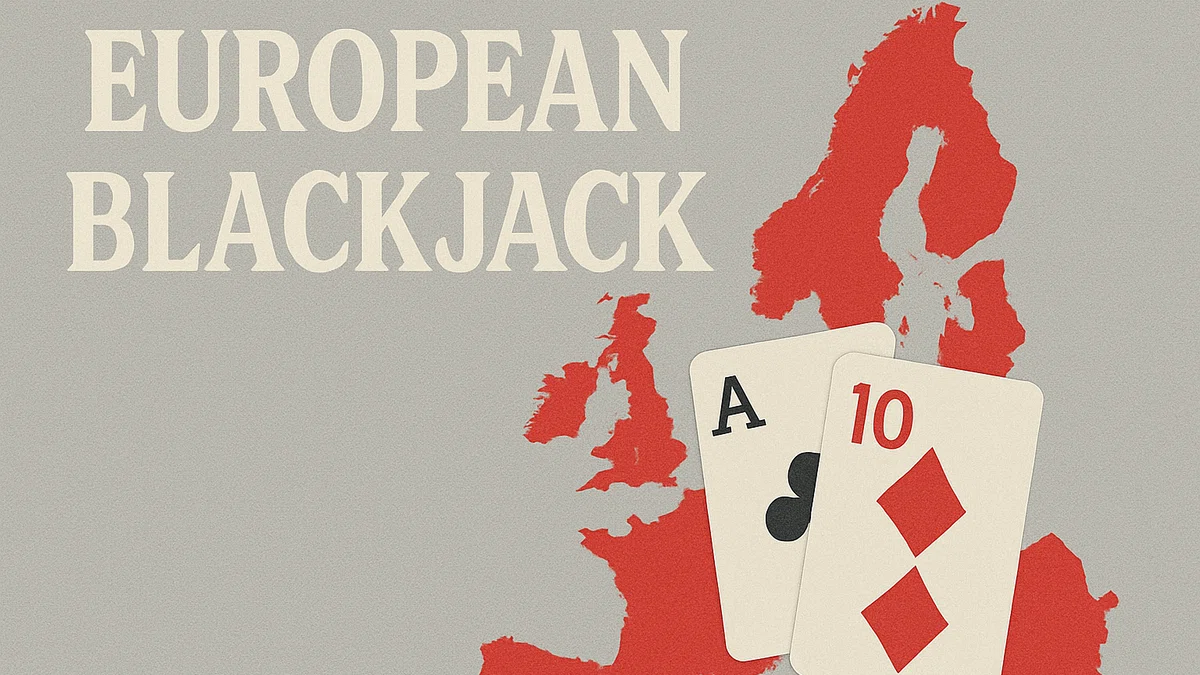Blackjack is a much-loved casino social casino game, but did you know there are many different ways of playing it?
One of the most popular variations is European blackjack. Before rushing to this variant of the game, take the time to learn:
- What is European blackjack
- What steps do you need to follow
- What to take into account when playing it.
Enjoy our guide.
What is European Blackjack?
In European blackjack, the dealer starts with one card. There’s no hole card and no peek. This increases your risk when doubling or splitting, as we will cover later.
European blackjack is usually played with two card decks. Unlike American blackjack versions, the dealer takes their second card after you play your hand. This key rule difference changes your game strategy. The game asks you to choose to hit, stand, double, or split cards before you know if the dealer has blackjack. More rules state that you can only double down on hands 9 to 11, and usually you are not allowed to resplit pairs – this can vary, though.
How to Play European Blackjack
In this blackjack variation, you play against the dealer while trying to reach 21 without “busting out”. If your hand score exceeds 21, you will lose the hand straight away. So, it’s a finely balanced game.
You need parts of strategy, playing skill, and sheer luck to win a European blackjack hand.
Here’s how a typical European blackjack hand works.
Pick how many Gold Coins (virtual currency used for fun) you wish to play. You get dealt two face-up cards while the dealer receives one face-up card. They don’t receive another card until your turn ends.
Now, with your first two cards choose one of the following actions:
- Hit – Hitting in blackjack is asking for another card.
- Stand – Keep your two cards and finish your turn.
- Double Down – Receive an extra card by playing double your original coins. After doubling, you must stand.
- Split – Split two cards with the same value (like 7-7 or Q-Q) into two separate hands. You may split aces once, and each ace gets one more card.
European blackjack is different from American blackjack. The dealer doesn’t check for blackjack when showing an Ace or 10, So, you must decide to double or split “blind”. If the dealer’s second card has blackjack, you lose all credits played on your hand – unless you also have a blackjack.
European Blackjack in Action
Next, let’s see how European blackjack works in a simulated game round – using example values.
First, decide how many Gold Coins to play in the current round.
Dealing
You receive two cards: a 9 and 6 to total 15. The dealer gets dealt one card face up, which is a 10. The dealer hasn’t received their second card yet.
Gameplay Choice
Your 15 versus the dealer’s 10 brings up an important decision. You might decide to hit on 15 to avoid standing on a weak hand. After hitting, your next card is a 6, giving you a new total of 21. You choose to stand on 21 because it’s the best hand possible.
The Dealer Plays
Next, it’s the dealer’s turn. They will be hoping to match your 21. The dealer’s second card arrives and it’s a 6, meaning their cards total 16. Going by the game rules, the dealer must hit on 16. The dealer takes another card, which is a 9, for a total of 25. So, the dealer’s hand is bust.

Hand Results
Your 21 trumps the dealer’s busted hand, meaning you win this play round.
The above example shows you must decide how to play your hand, with zero knowledge regarding the dealer already having blackjack. In American blackjack, the dealer checks for blackjack on a 10.
Related Posts:
Tips for Playing European Blackjack
Basic Strategy
Check our basic blackjack strategy guide. This shows you how to play in each hand situation. Like choosing whether to hit, stand, double down or split.
For instance, the dealer can still have blackjack after you double down, meaning your extra play would be risky. So, reconsider doubling if the dealer’s up-card is an Ace or 10.
Likewise, splitting in European blackjack can be a risky play. The no peek rules mean if you split and the dealer has blackjack, you lose both separate hands.
Common Mistakes
Try to avoid these basic errors to play within your limits:
- Risky moves: Because you won’t know if the dealer already has blackjack, aggressive plays like doubling or splitting against 10s and Aces.
- Not using basic strategy: Playing on a hunch or emotion like standing on 16 (a weak hand) versus a dealer 10.
- Not considering your risk tolerance: European blackjack has a higher house edge than American blackjack.
European Blackjack Alternatives
- Blackjack Switch: Play with two hands, where you can switch your second card between both hands.
- Vegas Strip Blackjack: Features 4 decks. The dealer always stands on soft 17 and can check for blackjack immediately on an Ace or 10 card.
- Spanish 21 Blackjack: A fast-paced game with 6 or 8 decks of 48 cards, not including number 10 cards. But you can double after splitting and late surrender.
- Atlantic City Blackjack: A game with 8 decks. Like European blackjack, the dealer always stands on soft 17, and you may double down on any card even after splitting. Atlantic City blackjack also offers late surrender.
Summary
Whether you’re new to McLuck social casino or an experienced player, this is a blackjack version worth trying!
Simply check out the game rules and enjoy a fun yet challenging experience today.

